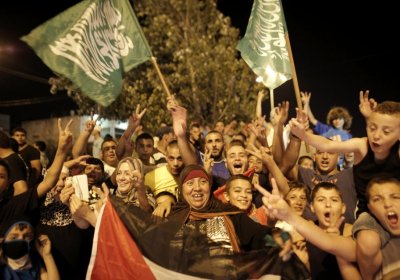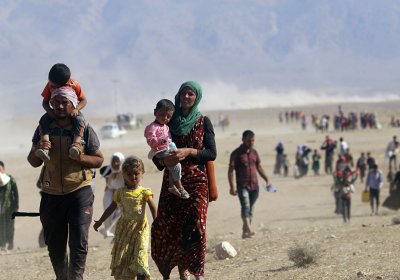Palestinians in Gaza took to the streets on August 26 in celebration. After 51 days of merciless bombardment by the Israeli military, an open-ended ceasefire between Palestinian resistance groups and Israel was announced that appears likely to last for at least the immediate future.
During the assault, homes, hospitals, shops, agricultural infrastructure and schools were pulverised. About 2100 Gazans were killed. An estimated 80% of these were civilians, including more than 500 children.
Tony Iltis
The US has been carrying out air-strikes in Iraq since August 8 for the first time since officially ending their occupation at the end of 2011.
The strikes were aimed at the extremely violent multinational terrorist group previously known as Islamic State of Iraq and Syria, but which recently renamed itself Islamic State (IS) to reflect its global ambitions.
Protesters took to the streets of Melbourne on August 16 to condemn human rights abuses by Saudi Arabia and to call for the release of Shia cleric Ayatollah Nimr Baqr al-Nimr, who has been sentenced to death by crucifixion and beheading for calling for religious freedom in the kingdom.
Saudi Arabia is both an absolute monarchy and a theocracy. The regime promotes a Wahhabi interpretation of Sunni Islam, notorious for narrowly defining Islam and intolerance toward other beliefs.
“This is not a war. It is genocide,” reads a popular slogan on homemade signs at protests against Israel’s current attack on the Gaza Strip.
The body count is enough to illustrate the one-sidedness of the violence. For the first nine days of their assault, Israeli forces pounded the besieged territory from the land, sea and air, but did not send forces in. About 250 people were killed in these nine days. Only one was Israeli.
Malaysian Airlines lost its second Boeing 777 this year on July 17, when flight MH17 from Amsterdam to Kuala Lumpur was apparently hit by a missile over war-torn Eastern Ukraine, killing all 298 people on board.
The incident happened while the Ukrainian army was carrying out a huge land and air offensive to crush breakaway republics in eastern Ukraine, over whose territory the plane was shot down.
Most passengers were Dutch, but 38 Australians were also killed.
A US drone attack in North Waziristan in Pakistan’s Federally Administered Tribal Areas (FATA) killed 20 people on July 16. It brought the number of people killed by US drones in North Waziristan since June 12 to 50.
The July 16 Nation reported, “five drones are still flying over the Datta Khel area and hampering the relief activities underway there. This … is fomenting a fear of the death toll rising.”
US President Barack Obama announced the deployment of 300 special forces troops to Iraq on June 19. It followed a week of denials that the US would respond militarily to the rapid advance toward Baghdad of anti-government forces led by the Sunni fundamentalist Islamic State of Iraq and Syria (ISIS).
The evacuation of a besieged settlement of 1300 displaced people by the UN-sanctioned French and African Union peacekeeping forces on April 27 marked the disappearance of the Muslim community of Bangui, capital of the Central African Republic (CAR). Until last year, 100,000 of Bangui’s 734,000 inhabitants were Muslim.
Deutsche Welle said that day that after the convoy left with the displaced people, crowds chanted “Liberation!” and “We have cleaned Central African Republic of the Muslims!” They looted the deportees’ homes and trashed one of the city's few remaining mosques.
More than 270 female secondary students were kidnapped on April 14 as they sat matriculation exams in the north-east Nigerian town of Chibok.
The kidnappers were members of a religious cult that calls itself Jama‘at Ahl as-Sunnah lid-da‘wa wal-Jihad — Arabic for Congregation of the People of Tradition for Proselytism and Jihad.
The group is more commonly known by its Hausa nickname, Boko Haram, which translate — very loosely — as “Western education is filthy”, although this is not a name that the group itself uses.
The United Nations general assembly voted on March 27 ― with 100 votes for, 11 against and 58 abstentions ― to not recognise the results of the March 16 referendum in Crimea. In the poll, most voted for the territory to leave Ukraine and join Russia.
The resolution was put by Ukraine and sponsored by the United States, the European Union and other Western powers, including Australia.
Russian President Vladimir Putin announced legislation on March 18 accepting the formerly Ukrainian Republic of Crimea and City of Sevastopol into the Russian Federation. The legislation was passed by the Russian Duma (parliament) on March 20.
Crimea and Sevastopol had voted in a March 16 referendum to leave Ukraine and join Russia. This was the culmination of a process that began after the February 21 overthrow of unpopular Ukrainian president Viktor Yanukovich by protesters in the capital Kiev.
The February 21 collapse of the government of Ukrainian president Viktor Yanukovich in the face of anti-corruption protests has led to the most serious confrontation between the US and Russia since the end of the Cold War.
The Russian Federation is not the superpower the Soviet Union once was, but it remains the world’s second largest nuclear power after the US, which has about 80% of the world’s nuclear weapons.
The US and its allies are insisting that Ukraine is indivisible, including the autonomous region of Crimea.
- Previous page
- Page 11
- Next page










